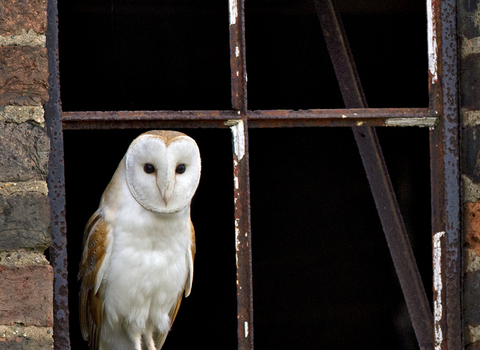
Barn owl ©Danny Green, 2020Vision

©Andy Rouse/2020VISION

©Jon Hawkins Surrey Hills Photography
Barn owl
Scientific name
Tyto albaWhen to see
January to DecemberSpecies information
Category
Statistics
Length: 33-39cmWingspan: 89cm
Weight: 300g
Average lifespan: 4 years
About
Perhaps our most familiar owl, the barn owl will sometimes hunt in the daytime and can be seen 'quartering' over farmland and grassland looking for its next small-mammal meal. However, it is perfectly adapted to hunt with deadly precision in the dark of night: combined with their stealthy and silent flight, their heart-shaped faces direct high-frequency sounds, enabling them to find mice and voles in the vegetation.How to identify
The barn owl has a mottled silver-grey and buff back, and a pure white underside. It has a distinctive heart-shaped, white face, and black eyes.Distribution
Widespread, but absent from the Highlands of Scotland and under threat in Northern Ireland.In our area
It is estimated there are just 200 breeding pairs of Barn Owl in Shropshire. Within their range a breeding pair require a minimum of four hectares (ten acres) of rough, tussocky grassland which is permanent and ungrazed.
You can watch some amazing footage of barn owls using nest boxes at http://tiptonscroft.org.uk/blog/ and find out more about them on the Shropshire Barn Owl Group website here
Did you know?
Throughout history, barn owls have been known by many different nicknames, such as 'ghost owl', 'church owl' and 'screech owl'. But the name 'demon owl', in particular, illustrates how they were considered by some rural populations - something not so difficult to understand when you hear their piercing shrieks and hissing calls.Watch
Barn Owl by Russell Savory (https://vimeo.com/442049233)
Barn Owl by Russell Savory
It is estimated there are just 200 breeding pairs of Barn Owl in Shropshire. Within their range a breeding pair require a minimum of four hectares (ten acres) of rough, tussocky grassland which is permanent and ungrazed.
You can watch some amazing footage of barn owls using nest boxes at http://tiptonscroft.org.uk/blog/ and find out more about them on the Shropshire Barn Owl Group website here

